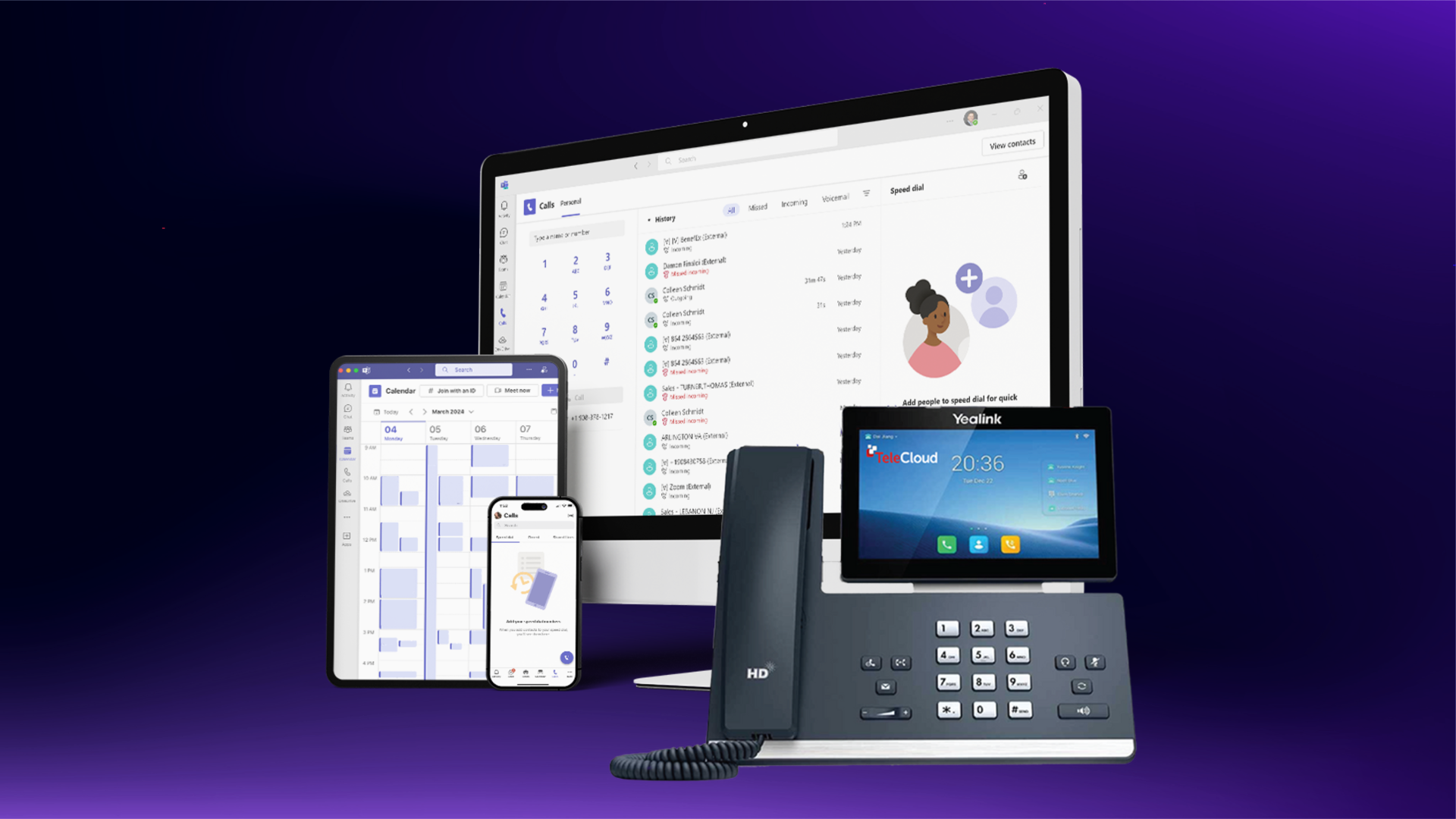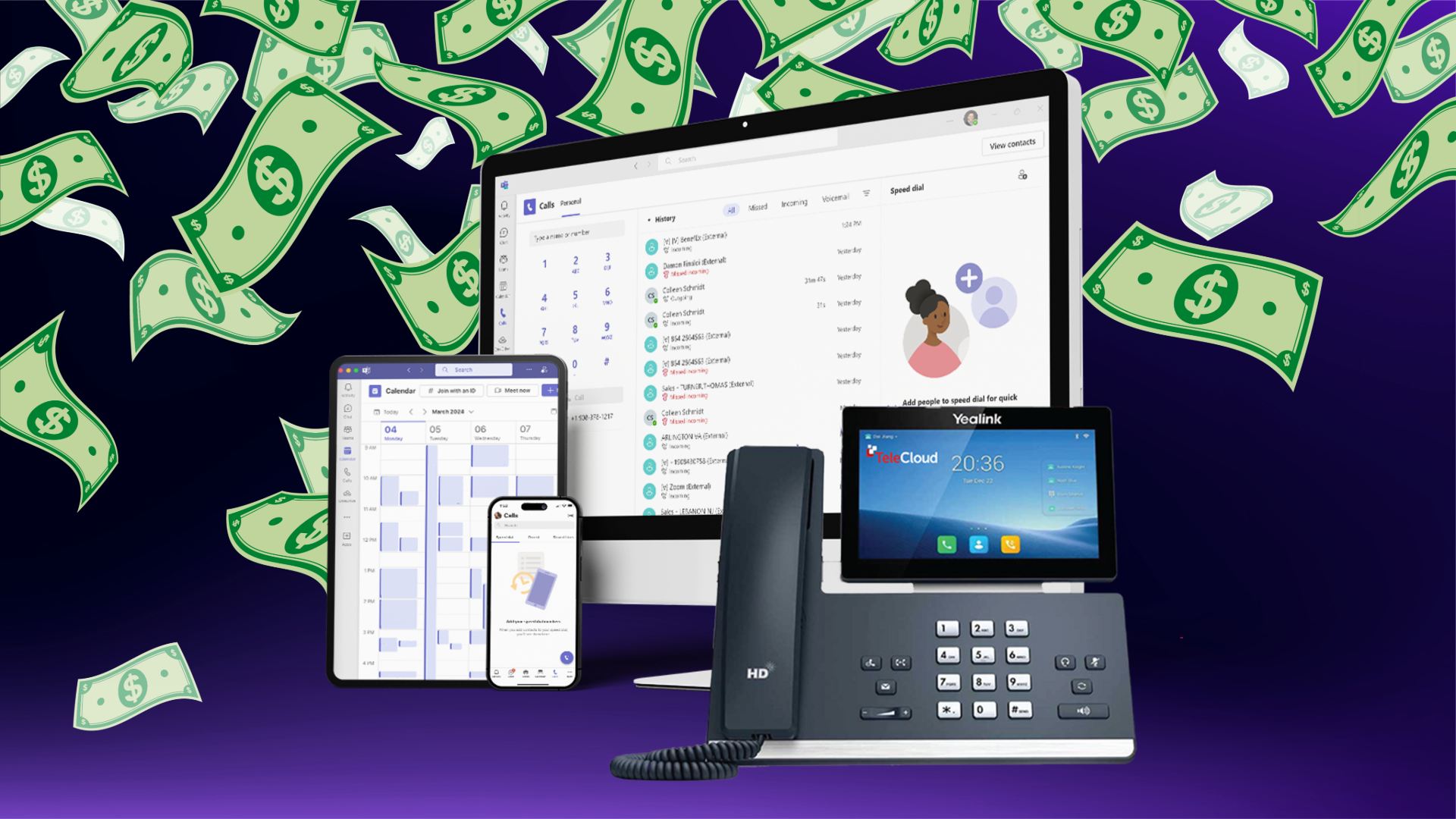
Microsoft Teams Calling can be a solid option for large enterprises deeply invested in Microsoft 365, especially those with access to volume licensing and dedicated Microsoft support. But for most small and mid-sized businesses, the costs, complexity, and limitations outweigh the benefits.
While Teams offers great internal collaboration, enabling external calling through Microsoft's native platform often means added licensing fees, limited call features, and increased support challenges. What most businesses truly want is the ability to make and receive calls inside the Teams app, without sacrificing quality, flexibility, or analytics.
That’s where integrating Microsoft Teams with a UCaaS provider like TeleCloud becomes a cost-effective, user-friendly solution. It allows businesses to retain full-featured call performance and support, while still using Teams as their calling interface.
This guide explores the differences between Teams Calling and direct routing integration. We’ll break down what Microsoft offers, what it costs, and why integration is often the better investment for SMBs looking to get more for their money.
Table of Contents
- What Does Microsoft Teams Calling Actually Offer?
- How Much Does Microsoft Teams Calling Cost?
- What Does It Cost to Integrate Microsoft Teams with Your Phone System?
- Why Is Teams Calling Often Overhyped for Small Businesses?
- Who Does Microsoft Teams Calling Work Best For?
- What’s the Better Option for Most Small to Mid-Sized Businesses?
- Real Example: When Teams Phones Became a Problem
- Frequently Asked Questions
What Does Microsoft Teams Calling Actually Offer?
Let’s clarify what Teams Calling actually means. Out of the box, Microsoft Teams already gives you the ability to:
- Chat with colleagues
- Host video meetings
- Make internal Teams-to-Teams calls (even across companies)
What it doesn’t include is the ability to dial a phone number or extension outside your Teams environment. To enable external calling, you need:
- A Microsoft Phone System license (additional cost)
- A Calling Plan or Direct Routing setup
That’s where things get complicated. You’re now dealing with porting phone numbers, configuring dial plans, managing devices, and troubleshooting an ecosystem Microsoft doesn’t fully support for smaller businesses.
How Much Does Microsoft Teams Calling Cost?
Microsoft Phone System licenses typically cost around minimum $4 per user per month. To enable external calling, you also need a Calling Plan, starting at $17 per user per month (for domestic calling). That puts the minimum cost at $21 per user/month for basic calling functionality.
And for most SMBs (small and mid-sized businesses), Microsoft doesn’t offer discounts, dedicated reps, or personalized support. Unless you're a large enterprise, you’ll pay full price and still need to navigate complex setup and limited tools.
That base-level price might seem acceptable until you compare it to what you could get from a Teams integration.
What Does It Cost to Integrate Microsoft Teams with Your Phone System?
If you’re already using a UCaaS provider like TeleCloud, integrating Teams is both simple and cost-effective, especially compared to Microsoft’s full Calling Plan.
Microsoft Teams Calling is included in our Pro calling plan, priced at $24.99 per user/month, plus a one-time setup fee for initial configuration, secure connection to Microsoft 365, and user syncing.
This setup allows you to:
- Make and receive calls directly in the Microsoft Teams app
- Use TeleCloud’s advanced call routing, analytics, and reporting
- Avoid the setup, management, and support headaches of Microsoft’s native calling system
There is also a one-time setup fee to configure the secure integration with Microsoft 365, sync users, and activate Teams calling capabilities.
Take a quick look at both options side by side:
| Microsoft Calling Plan | TeleCloud Teams Integration | |
|
Base Phone License |
$4 |
$24.99 |
|
Calling Plan |
$17+ |
N/A |
|
Teams Integration |
Included |
Included |
|
Total Monthly (per user) |
$21+ |
$24.99 |
|
Advanced Reporting |
Limited |
Full |
|
Hardware Costs |
High |
Moderate |
|
Porting and Setup Complexity |
High |
Handled by Provider |
|
Support Level |
Limited (unless large) |
Dedicated Concierge Support |
Bottom line: While the sticker price may appear similar, the value and experience you get with TeleCloud’s Teams integration far exceed what Microsoft’s native offering provides. For SMBs especially, it’s the smarter investment.
Why Is Teams Calling Often Overhyped for Small Businesses?
Many businesses say, “We want Teams,” without realizing what that actually involves. The reality is:
- Queues and auto-attendants are still maturing. Microsoft only rolled these out in early 2025 and with bugs.
- Support is limited. Unless you’re a large enterprise, you’re not getting a dedicated rep. Most small businesses deal with long ticket queues and inconsistent support.
- Call reporting is weak. If you care about call outcomes, agent performance, or lead tracking, Microsoft’s tools fall short.
- Programming and porting are a pain. Setting up phone numbers, extensions, and routing flows inside Teams takes specialized training or outside help.
- Hardware is expensive. A Teams-certified Yealink phone might cost 2.5x what a standard model does, just to carry the Microsoft logo.
For a typical 25- to 100-user business, this is over killand overpriced.
Who Does Microsoft Teams Calling Work Best For?
If you’re a massive organization with an existing enterprise agreement, Microsoft might drop the price significantly. One company we spoke with (750 users) was offered Teams Calling for $1.50 per user because they were already deep into Microsoft licensing.
Teams Calling works best for:
- Enterprises with dedicated Microsoft support
- Non-call center teams that don’t rely on detailed reporting or custom call flows
- Internal communication-focused organizations that just want to centralize tools in one app
If your business doesn’t fit these criteria, it’s time to consider other options.
What’s the Better Option for Most Small to Mid-Sized Businesses?
If you still want to make and receive calls in the Teams app, but don’t want the cost and complexity, direct routing is your best path.
Direct routing allows you to:
- Keep using Teams for your internal tools
- Route external calls through your UCaaS provider (like TeleCloud)
- Avoid Microsoft’s complex provisioning and support gaps
- Get full-featured reporting, analytics, and call control
This gives you the best of both worlds. Your team can answer calls in the Teams app or on a desk phone—and your business keeps the flexibility and support of a dedicated telecom partner.
Real Example: When Teams Phones Became a Problem
A mid-sized customer wanted to switch to Teams Phones ahead of a Microsoft rollout. The problem? They already had a fully functioning TeleCloud system and wanted to swap out supported phones for Teams-certified devices.
But those phones wouldn’t be able to make external calls until the Teams Phone setup was complete, potentially six months or more. They would’ve spent more money on phones that couldn’t function the way they needed, simply to “get ready for Teams.”
That story’s common. Customers often conflate internal Teams use with full voice platform readiness. The two aren’t the same, and misunderstanding that difference leads to costly mistakes.
Don’t Confuse Familiarity with Functionality
Microsoft Teams is a great collaboration tool. But calling is a different story.
If your business depends on phone performance, uptime, reporting, and customer experience, Teams Calling probably isn’t worth the price or effort. Especially for SMBs, it’s often better to let Teams handle what it does well (meetings and chat) while your UCaaS provider takes care of your voice infrastructure.
Direct routing lets you answer and place calls in the Teams app without locking yourself into a complex, expensive, and under-supported system.
Want to integrate Teams Calling the smart way? Schedule a strategy session with a TeleCloud expert and explore direct routing options that make sense for your business.
Frequently Asked Questions
Can I use Microsoft Teams for internal calls without a calling plan?
Yes, you can use Teams for internal chat, video, and one-to-one calls without a calling plan. External calling requires additional licensing.
What’s the difference between Teams Calling and Teams integration via direct routing?
Teams Calling uses Microsoft’s own infrastructure and plans, while direct routing connects Teams to your UCaaS provider for external calls—offering more flexibility, reporting, and control.
Is Teams Calling reliable for high-volume or call center environments?
Generally no. Microsoft’s system lacks the depth of reporting, call flow controls, and reliability required by high-volume teams.
Why is Microsoft Teams Calling more expensive for SMBs?
Smaller businesses don’t qualify for discounts and receive less support, often paying full list price for a product that may not meet their needs.
How difficult is it to switch to a TeleCloud Teams integration?
It’s fast and handled by our support team. We manage the setup, integration, and ensure your users can make and receive calls in Teams with minimal disruption.
Can I still use my current phones with Teams integration?
Yes, in most cases. Teams integration via TeleCloud works with a variety of standard desk phones and softphones, avoiding the need for costly Microsoft-certified devices.
Topics:





